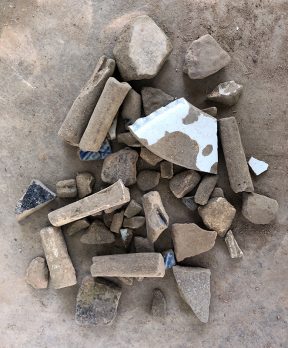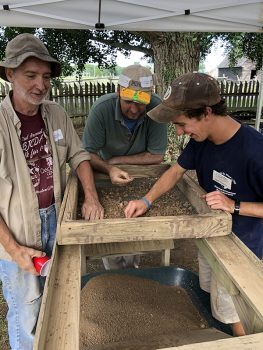Back to Dispatches from Field School
Field School 2018 – Week 8
Mace Long — Indiana University of Pennsylvania
“High Water for Tidewater Archaeology Weekend”

An assortment of ceramics and tobacco pipe fragments found in the plowzone of one of our excavation units
As Week Eight rolls in at Historic St Mary’s City, this became one of, if not the, most important week for all of us at the Field School in Historical Archaeology: the event known as Tidewater Archaeology Weekend was arriving. This is when members of the public are invited to come in and sift through dirt with us and enjoy special, behind-the-scenes tours of our sites and facilities. The importance of the event is to engage with the public by providing a hands-on experience where everyday people get to discover the artifacts and learn by experience what it is like to be an archaeologist.
The main method to accomplish this goal is to gather as much soil as possible with the usage of shovels and large plastic tubs rather than the traditional trowel and dust pan. A large amount of soil was needed because of the large quantity of people that we expected for the event. It would be quite awkward if we ran out of soil and there were still large amounts of people eagerly waiting to screen for artifacts! During the weekend, there were a variety of artifacts that were discovered. In one unit of our archaeological site, Unit 923, there were three objects of interest that were found in the span of several minutes! The artifacts were a large iron ring, half of a horseshoe, and an unidentified iron object. Each of these relics had a different meaning. The horseshoe, the second one found at the Calvert House site this season, had the importance of horse activity. Possibly, this indicated where the horses were kept since the colony required that ordinaries have stable space for many horses, sometimes up to as many as twenty. These horses would then be used for transportation or for communication purposes. The unknown iron object was a mystery but may be either be part of a firearm or a door hinge.

Tidewater Archaeology Weekend regulars Gary (left) and Brian (middle) with field school student Kyle Vanhoy
Our preparations paid off with an engaging Tidewater Archaeology Weekend for the public. Despite some heavy rain, it was a success due to the arrival of plenty of people with umbrellas and raincoats to participate in the sifting and discovery of artifacts. My perspective changed with potential ways for information to be given to the community. I previously favored visual and verbal presentations along with readings in books. During Week Eight, I was able to witness the incredible instructive value of allowing people of all ages to sift through the dirt themselves and be educated physically with exciting hands-on participation. Tidewater Archaeology Weekend shaped both the public’s knowledge of the archaeological processes and our own perspective of the ways we can reach out and share the unearthing of artifacts with wider audiences.


